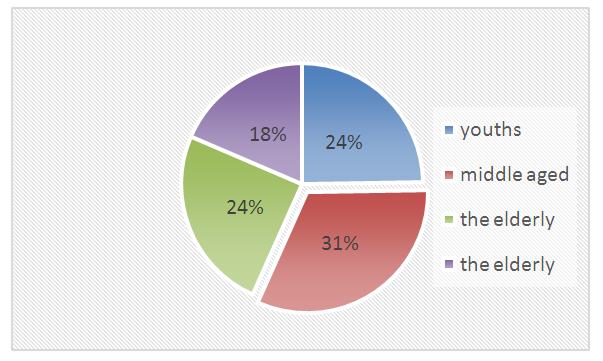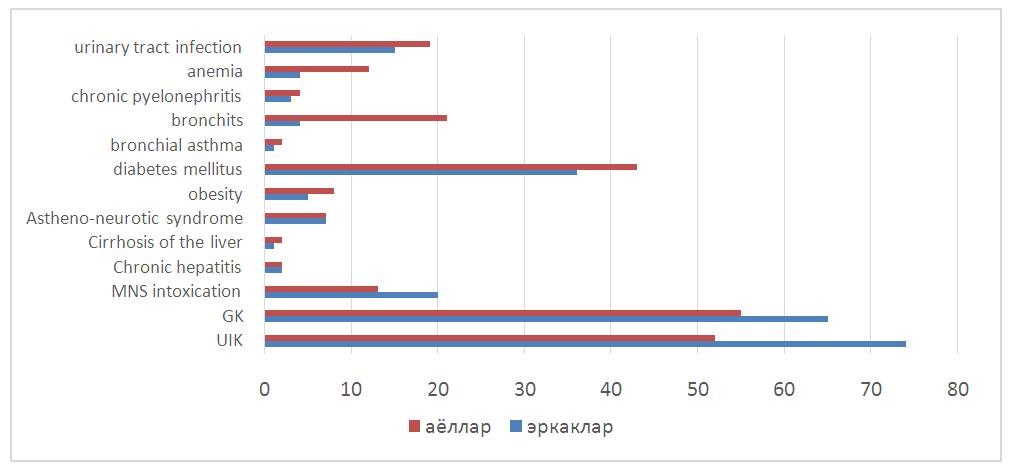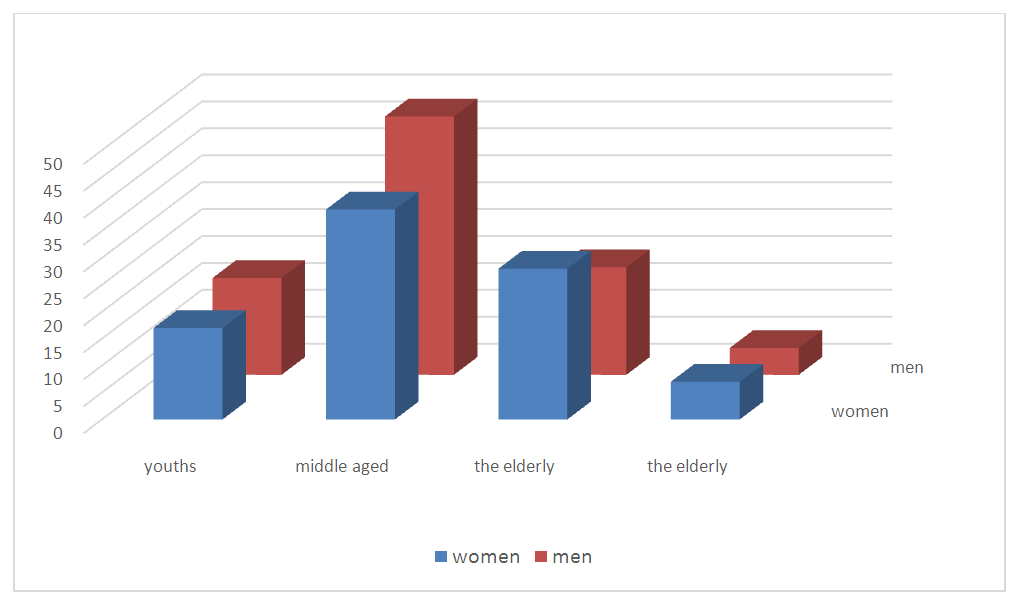-
Paper Information
- Next Paper
- Previous Paper
- Paper Submission
-
Journal Information
- About This Journal
- Editorial Board
- Current Issue
- Archive
- Author Guidelines
- Contact Us
American Journal of Medicine and Medical Sciences
p-ISSN: 2165-901X e-ISSN: 2165-9036
2021; 11(2): 145-147
doi:10.5923/j.ajmms.20211102.17
Received: Feb. 4, 2021; Accepted: Feb. 25, 2021; Published: Feb. 28, 2021

Determination and Analysis of Changes in the Hepatobiliar System in Patients with COVID-19
Sobirova G. H.1, Bafoyeva Z. O.2
1Head of Balneology Department, Republican Scientific-Practical Medical Center of Specialized Therapy and Medical Rehabilitation, Uzbekistan
2Department of Rehabilitation, Folk Medicine and Physical Education, Tashkent Medical Academy, Tashkent, Uzbekistan
Correspondence to: Sobirova G. H., Head of Balneology Department, Republican Scientific-Practical Medical Center of Specialized Therapy and Medical Rehabilitation, Uzbekistan.
| Email: |  |
Copyright © 2021 The Author(s). Published by Scientific & Academic Publishing.
This work is licensed under the Creative Commons Attribution International License (CC BY).
http://creativecommons.org/licenses/by/4.0/

We retrospectively examined the medical history of 685 patients (25-90 years old) hospitalized with a diagnosis of coronavirus in the 2nd clinic of the Tashkent Medical Academy. Data obtained (age, sex, comorbidities, days of hospital treatment, laboratory parameters), mainly patients with changes in the hepatobiliary system (those with increased levels of alanine transferase and aspartate aminotransferase enzymes) were selected and statistically analyzed. Our statistical analysis revealed an increase in alanine transferase and aspartate aminotransferase enzymes in 182 patients, mainly men, middle-aged (44-60 years), and those with severe disease.
Keywords: COVID-19, Liver, ALT, AST
Cite this paper: Sobirova G. H., Bafoyeva Z. O., Determination and Analysis of Changes in the Hepatobiliar System in Patients with COVID-19, American Journal of Medicine and Medical Sciences, Vol. 11 No. 2, 2021, pp. 145-147. doi: 10.5923/j.ajmms.20211102.17.
1. Introduction
- The new coronovirus (COVID-19) disease of 2019 has affected nearly 100 million people to date, with nearly 2 million people becoming victims of the disease. [1]. SARS-CoV-2 is an etiological agent that causes pneumonia, cough, episodic diarrhea, headache, heart damage, and liver changes in some patients, a condition that is more common in patients with caries and concomitant diseases.Patients with liver dysfunction were also more common among patients admitted to the hospital with Covid-19 Elevations in alanine aminotransferase (ALT) and aspartate aminotransferase (AST) occurred in 16-53% of patients. [2]. Covid-19 in severe cases liver dysfunction became more severe. In China, when patients were hospitalized, an increase in AST / ALT was found in 18.2 / 19.8% of mild patients and 39.4 / 28.1% of severe patients. [3]. Another small number of patient observations in China showed that AST increased by 62% in those in need of intensive care and by 25% in those who did not. [4]. In subclinical patients, AST and ALT were increased in 8.7 and 8.9% of patients, respectively [5]. In 5,700 patients in New York, 58.4% had an AST> 40 Ed / l and 39% had an ALT> 60 Ed / l. [6]. In this cohort, 56 patients (2.1%) developed acute liver failure, with AST and ALT> 15 times higher than the upper limit of normal. Of these 56 patients, 3 were 18–65 years of age (3/1373, 0.2%) and recovered from the hospital, and 53 died. 25 were aged 18–65 years (25/134, 18.7%) and 28 were> 65 years of age (28/469, 6.7%). [6]. Therefore, the frequency of liver damage depends on the severity of the disease.Liver damage in patients with coronavirus infection may be directly related to viral infection of liver cells, as pathological studies in patients with ARVI have confirmed the presence of the virus in liver tissue. Angiotensin-synthesizing enzyme 2 (ACE2) is also represented by unwanted cellular receptors for SARS-Cov-2, liver and bile duct cells [7]. Because its expression is significantly higher in bile duct cells, liver injury to Covid-19 appears to be more related to liver cell damage. [7]. However, this has not yet been confirmed in patients with Covid-19 [6]. Elevation ALT / AST levels may cause hepatotoxic effects of the drug, hypoxia associated with cytokine storms, and / or pneumonia [2], [7].To what extent Covid-19 is involved in liver damage, the processes that take place in it have not yet been well studied and still require a lot of research.
2. Materials and Methods
- We retrospectively examined the medical histories of 685 (25-90 years old) patients were treated with coronavirus from July 19 to August 16, 2020 at TTA 2 Clinic according to (sex, age, diagnosis, and etc.), we selected patients with changes in the hepatobiliary system and conducted a statistical analysis.
3. Results
- The results showed that a total of 685 patients were hospitalized. Of these, 54% (371) were women and 46% (314) were men. 84% (575) were cured and discharged from the hospital, 16% (110) were seriously ill. Patients were hospitalized for an average of 10 days. 99% of patients were from Tashkent. All patients were suspected of coronovirus, 2-3% confirmed Covid-19, 2-3% were diagnosed with respiratory disease, and the remaining patients were diagnosed with bilateral coronavirus. 88.5% of patients (606) complained mainly of sore throat, cough, wheezing, shortness of breath, and pain under the ribs.In the table below, we can see the percentage distribution of patients by age, and the majority (31%) are middle-aged. (Figure 1)
 | Figure 1. Distribution of total patients by percentage |
 | Figure 2. Incidence rates of co-morbidities among total patients |
 | Figure 3. Distribution of ALT and AST increases by age and sex |
4. Discussion
- Comparing the data obtained with the results of foreign countries: changes in foreign countries have been found to increase AST more than ALT, mainly in the elderly, men, the severity of the disease, and a large proportion of deaths occurred in these patients.In our TTA 2 clinic, changes in the hepatobiliary system were observed, mainly in middle-aged men, with a greater increase in AST than in ALT. The severity of the disease and the mortality rate were also recorded among us among these 182 patients.
5. Conclusions
- 1. In the TTA clinic, enzymes were increased in 26.6% of 685 patients.2. Of the 685 patients, 11.5% had complaints of digestive problems.3. The disease and changes in the hepatobiliary system were more common in middle-aged (44-60 years) men.4. Basically, more changes were found in AST than in ALT.5. Mortality and severity of the disease were higher among 182 patients.
 Abstract
Abstract Reference
Reference Full-Text PDF
Full-Text PDF Full-text HTML
Full-text HTML